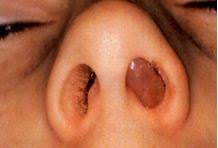 Nasal polyp is not uncommon in children and parents often get afraid of it when it is visible.
Nasal polyp is not uncommon in children and parents often get afraid of it when it is visible.
It is rare below the age of 10 yeras.
It is an abnormal growth which is semitransparent and may arise from any portion of nasal mucosa or epithelium of paranasal sinuses usually at its outflow.
Contrary to the common belief,it is associated more commonly with non allergic than allergic conditions.
It is seen more commonly in children with non allergic asthma than allergic asthma
It may be single or multiple depending on etiology.
CLINICAL FEATURES:
Small polyps are asymptomatic which are usually discovered during nasal examination for other causes,when they are located anterior to the anterior edge of middle turbinate
Symptoms depend on size and location of the polyp.
Small polyp arising from middle meatus may produce symptoms by blocking the outflow tract,causing chronic and recurrent sinusitis.
common symptoms are
Rhinorrhoea,
post nasal drip
facial pain
headache
toothache
hyposmia,
anosmia,
loss of taste,
blocked nose,
snoring.
When the size becomes large,it may cause obstructive sleep apnea
DIAGNOSIS;
Clinical examination is sufficient for the idendification of this lesion.Anterior rhinoscopy wll defines it.
Non contrast CT scan of nasal and paranasal sinuses are required to see the extent of lesions as in rare circumstances there may be malignant lesions.SO the imaging investigation of choice is non contrst CT scan.
CAUSES:
It arises due to chronic inflammation of nasal or paranasal mucosa,so it is commonly seen in children with allargic or non allergic rhinitis or sinusitis.
Multiple polyps are seen in children with cystic fibrosis,primary ciliary dyskinesia ,asthma and allergic fungal sinusitis.
TRATMENT:
Treatment is medical in most of the cases.Surgery is required only rarely when medical treatment fails.
In most of the cases ,short term oral corticosteroid and or intranasal steroid is needed.
REFERENCES:
Bernstein JM, Gorfien J, Noble B. Role of allergy in nasal polyposis: a review. Otolaryngol Head Neck Surg. 1995 Dec. 113 (6):724-32. [Medline].
Tos M, Sasaki Y, Ohnishi M, Larsen P, Drake-Lee AB. Fireside conference 2. Pathogenesis of nasal polyps. Rhinol Suppl. 1992. 14:181-5. [Medline
Rudmik L, Schlosser RJ, Smith TL, Soler ZM. Impact of topical nasal steroid therapy on symptoms of nasal polyposis: a meta-analysis. Laryngoscope. 2012 Jul. 122 (7):1431-7. [Medline].
Lund VJ, Flood J, Sykes AP, Richards DH. Effect of fluticasone in severe polyposis. Arch Otolaryngol Head Neck Surg. 1998 May. 124 (5):513-8. [Medline
Rudmik L, Schlosser RJ, Smith TL, Soler ZM. Impact of topical nasal steroid therapy on symptoms of nasal polyposis: a meta-analysis. Laryngoscope. 2012 Jul. 122 (7):1431-7. [Medline].